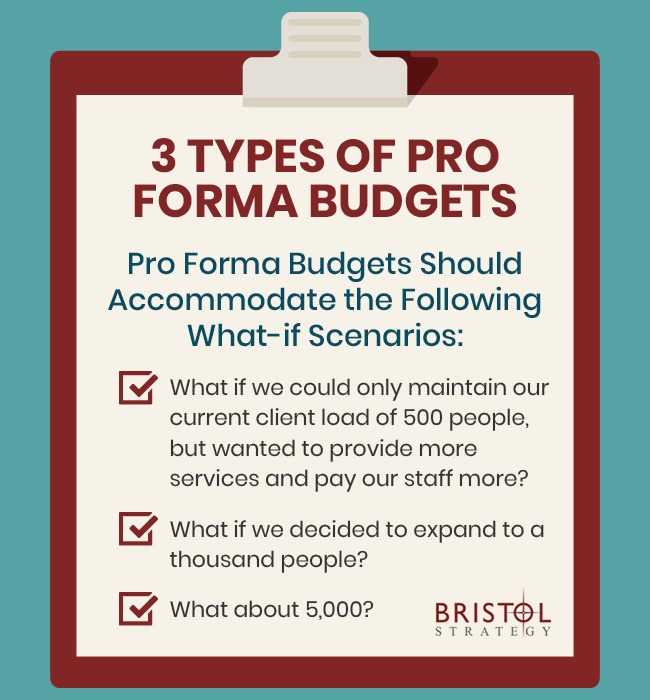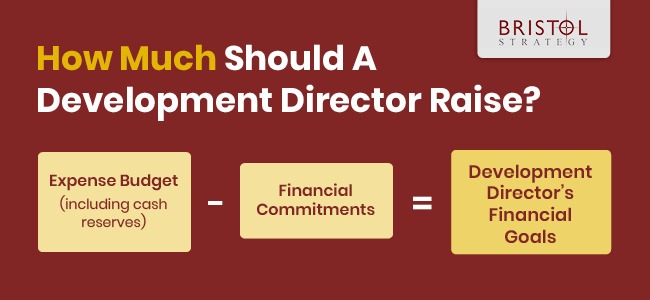.I’m sorry to tell you this, but there is no simple formula for how much a development director should raise, just as there is none for how much such a person should be paid. If anyone tells you the development director should raise X times their salary, they are simply sharing an urban myth.
However, that doesn’t mean you have to be in the dark about where to set expectations. A lot of factors will influence how much a development director should raise – and we’ll dive into them below:
- Specific to Your Organization
- What you mean by the title “development director.”
- the level of experience your team has with raising money
- Current Costs and Growth Goals
- The amount of money you need to operate your nonprofit effectively
- how much growth you’re seeking in the short, medium and long term
- Financial Commitments
- whether your organization has any multi-year pledges
- the number of donors and other funders you currently have
Development Directors’ Responsibilities Vary By Organization
And That Impacts How Much They Should Raise
Before you decide how much your development director should raise, think about what that title means in your organization – which will likely change based on the relative size of your organization
Development Directors at Smaller Nonprofits
Many smaller nonprofits have a single employee with the title of development director. But the title alone doesn’t really tell us what that employee is expected to do. Raise major gifts? Run all fundraising activities from the annual fund to corporate relations? Write grant applications?
It’s OK with me if your development director does all that, although I would hope they had achievable performance targets, and you don’t keep throwing new tasks at them, like another golf tournament. If their job description and performance expectations are not achievable, something(s) will not get done, the staff person will be miserable, and they will likely quit on you.
That’s not to say it’s a bad idea to have one employee; just to say, lay out reasonable expectations (which is why it’s a good idea to know how much they should fundraise and communicate that!). One person can only work so hard for so long before their fangs grow.
Development Directors at Larger Nonprofits
Larger organizations, on the other hand, are more likely to have anywhere from a few people to hundreds in the fundraising department. Larger organizations might also have different specialties within those departments like:
- Grant-seeking
- Corporate relations
- Annual-fund giving
- Major giving
In the larger, and largest, shops, the title “development director” most likely means the employee in charge of everything related to generating income. Or maybe the “development (or advancement) director” is only in charge of individual giving and oversees staff working in philanthropy. Sometimes the title for that senior-level employee is Chief Development Officer.
If the shop is relatively small, the development director probably does quite a bit of fundraising, while overseeing the work of the rest of the team including foundation and corporate relations.
Yeah, I’m confused too. Especially because in Europe, many other parts of the globe, and even sometimes in the U.S., the title “director” means “manager.” Managers are responsible for the performance of other people, not just themselves. Even directors of the governing board are responsible for the performance of the Executive Director or Chief Executive Officer.
Before moving on, please decide where your development director falls on the spectrum of responsibilities I’ve outlined above, ranging from the teeny-tiny one-person fundraising department to the employee who manages a cast of dozens or hundreds. If you’re on the teeny-tiny end of the spectrum, your income requirements will be lower, and vice versa.
What It Costs to Realize Your Vision
Now we must discuss what it costs today, next year and X years from now to fulfill your vision.
How Pro Forma Budgets Determine Development Director’s Fundraising Goals
This is where the pro forma budget comes into play, a concept familiar to Chief Financial Officers and accountants. This is a “what-if” budget showing how much it would take to run your operation if the organization needed to expand or shrink.
For example, let’s say you currently serve 500 clients, and you want to serve 5,000 instead. A pro forma budget would help you think through the total amount required to operate the business based on how much it would cost to operate at a future point, once you have acquired the facilities, staffing, technology, marketing and so on to serve ten times the number of clients you serve today, or done something else future-y.
A good pro forma budget requires thinking through all anticipated costs of the expansion, plus enough cash reserves to carry you through unforeseen disasters, like a pandemic, for example.
By the way, good pro forma budgets tend come in packages of three or more, to accommodate the what-if scenarios.

- What if we could only maintain our current client load of 500 people, but wanted to provide more services and pay our staff more?
- What if we decided to expand to a thousand people – AND pay our people more?
- What about 5,000, and ditto?
How much would each scenario require, accounting for more staff, facilities, equipment, supplies, and snack food?
Here’s what you need to do:
- What is your annual budget as of the end of the last fiscal year? Figure out about how much you spent, on what, and how much you stashed away in cash reserves (if any).
- If your current financial situation means you’re scraping by, underpaying employees, using recycled furniture, and working on ten-year-old computers, imagine what things would look like if you had enough money to pay your people a living wage, give them decent benefits, have up-to-date technology, and six months of operating money in cash reserves, before you undertake your expansion. Figure out how much that would cost. That’s your first what-if scenario.
- If you would like to grow the organization substantially and serve more people, then you have to ask:
- How many more clients would you serve (or programs would you run, or research you would do or whatever it is you want to expand)?
- How many more staff would you need, if any, to serve that expanded vision?
- What other costs would you incur, such as technology investments, employee benefits, health, property and casualty insurance, office space, and so on?
- How much would six months of operating cash reserves cost for each scenario?
Now you have an idea of the total amount of money you need to spend, getting us part of the way to deciding what your development director needs to raise. There are probably a few things that lower the total amount, and might make life easier for the development director.
Money that’s Already Committed to You
Multi-year giving is wonderful, isn’t it? If you have funding sources that are guaranteed for the next few years, your development director’s fundraising target will be a little less difficult to reach. Here are four examples.
- Your own endowment. According to Investopedia, “In general, an endowment is a donation of money or property to a non-profit organization, which uses the resulting investment income for a specific purpose.” Many nonprofits like to build up their own endowments (using donations dedicated to that purpose) so they can use the distribution for general operating funds. If your organization is large enough and old enough to have built such an endowment, AND you have enough money to operate without what’s locked up in the endowment, that’s great; you can guarantee a specific amount of income from that source. Thus, your development director’s fundraising target for the budget year will be that much lower.
- Planned gifts and related pledges. Many major donors prefer to spread out their gifts over several years, so they sign pledges to give a certain amount per year for several years. Or they give X amount for Y years, plus a bequest at the time of their death. Your development director’s fundraising target for the budget year will also be that much lower.
- Long-term underwriting by a corporate partner. These are great programs if you have the relationships, confidence, and skills to put them together. It’s nice to have a corporate sponsor pay for the centerpieces at your gala event, but a whole lot nicer if they underwrite one of your programs for five years. If you’re able to do so, the development director’s fundraising target for the budget year will again be that much lower.
- Multi-year grants. Grants often stretch out over several years. If you received the grant before the current budget year, your development director’s fundraising target for this budget year will therefore be that much lower.
Note for smaller nonprofits: Building an endowment and creating long-term underwriting commitments from corporate partners are fantastic options for mature organizations with lots of staff, a donor base with considerable wealth, and the vision, ability, and confidence to make a huge impact. Smaller nonprofits should avoid these options until they have grown to that point.
If you’re running a grassroots or startup nonprofit, put endowments on the shelf as something to tackle later, if ever. Your nonprofit needs cash to pay for operations and start a modest cash-reserves fund today. To build up long-term financial income, start with multi-year grants, recurring gift programs, and any version of individual giving from annual fund to major gifts.
A cautionary note – long-term commitments of income are contracts, but contracts can be broken. The grantor may run out of money. The corporate partner might go out of business. The planned giver might lose their wealth due to a Madoff-like scheme. The heirs might argue over the donor’s will and delay the distribution of the money forever. The government that made the multi-year grant might change their policies due to a new administration. The recurring donor might just cut off their credit card. That’s why you need to set aside enough cash to carry you in case something awful happens.
So How Much Should Your Development Director Raise?
OK, I lied. There is an answer to this question. Your development director should raise as much money as you need to meet your expense budget every year, including cash reserves and excluding the money you can already count on from endowments, pledges, multi-year grants and multi-year corporate commitments.

If you’re planning to expand your operations, leverage the pro forma budget to set your development director’s fundraising goals, in addition to the annual expense budget.
Now that you have a goal to work towards, the next step is to evaluate whether your development director has the tools, time, tech, and support to achieve it. As I mentioned above, make sure the goals and expectations you’re setting for your development director are reasonable. It might require additional investment, but equipped with a concrete fundraising goal, your board, leadership team, and development director will all be bought into the vision of achieving it.
So next time somebody, like a board member, asks, “So tell me. How much should our development director raise?” you have an answer.

